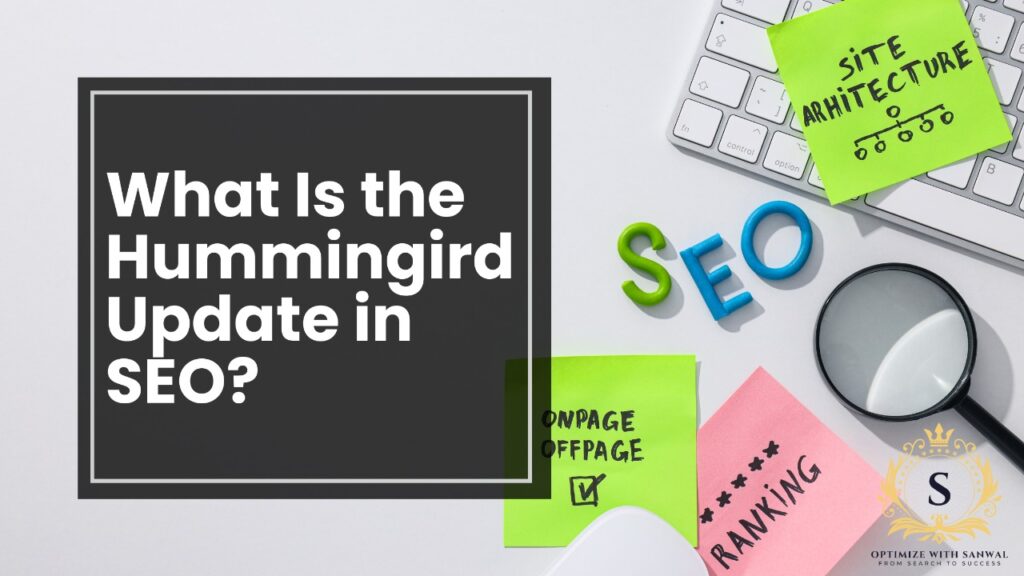What is the Hummingbird Update in SEO & How It Changed Search Results
A Practical Guide for Marketing Managers Navigating Search Algorithm Changes
Introduction
If you manage marketing for a small or mid-sized business, you’ve likely seen fluctuations in your website’s search performance over time. Sometimes it’s gradual, other times sudden. Often, the cause is not your campaign but a change in the way Google ranks and interprets content—commonly referred to as a Google search algorithm change.
One of the most influential of these changes was the Hummingbird update in SEO, which quietly reshaped how Google delivers search results. Introduced in 2013, Hummingbird didn’t just adjust ranking factors—it fundamentally changed how Google understands what users are asking for.
So, what is the Hummingbird update, why did it matter then, and why should it still guide your content strategy today?
This blog from OptimizeWithSanwal breaks it all down for you—with work-focused tips to help your business website adapt and thrive in today’s search landscape.
What is the Hummingbird Update in SEO?
The Hummingbird update was a major overhaul of Google’s core search algorithm introduced in August 2013. Unlike past updates like Panda or Penguin, which focused on specific ranking factors, Hummingbird rewrote the way Google processes queries.
Key Features of Hummingbird:
- It focused on semantic search, or understanding the meaning behind search queries
- It introduced natural language processing to better interpret full questions, not just keywords
- It helped Google understand context, user intent, and relationships between words
Rather than matching search phrases word-for-word, Google began to deliver results based on what it thought users actually meant—even if they didn’t use the perfect keywords.
Why It Was Named “Hummingbird”
Google named the update “Hummingbird” because it was designed to be “precise and fast,” much like the bird itself. The goal was to provide more accurate results, especially as people began using more conversational language in their searches.
How Hummingbird Changes SEO: Then and Now
The Hummingbird update SEO shift was subtle but deep. While your website might not have seen a sharp rise or fall overnight, the long-term impact has been significant—and continues today.
Let’s explore how.
Then: The Pre-Hummingbird Search Landscape
Before Hummingbird:
- Search engines relied heavily on exact keyword matches
- Short, keyword-rich content could still rank well
- Search intent was often misunderstood—leading to irrelevant results
- Websites optimized around singular keyword phrases, not natural questions
This system had limitations. A search for “how to fix slow WiFi” might deliver results filled with articles titled “Fix WiFi”—even if they didn’t actually explain anything.
After Hummingbird:
- Google began to analyze entire queries, not just target keywords
- Search results became more context-driven and accurate
- Pages that addressed real user questions and provided solutions started to outperform short, keyword-heavy ones
- SEO strategies shifted toward topic authority, not just keyword density
This update paved the way for other semantic-driven changes like RankBrain, BERT, and other modern AI search features.
Why the Hummingbird Update Still Matters in 2025
Although over a decade old, the principles behind the Hummingbird update remain essential—especially as voice search, mobile search, and conversational interfaces grow.
If your content still relies heavily on keywords without addressing the full intent behind a search, you may be missing out on traffic, engagement, and conversions.
Here’s why Hummingbird-era thinking still drives modern SEO:
1. People Use Longer, More Conversational Queries
Whether typing or speaking, users now ask full questions. Your content should match that style to remain relevant.
2. Google Is More Contextual Than Ever
Google looks at the topic, language, and searcher’s history or location. Pages that cover a topic in depth and answer real-world questions tend to rank higher.
3. Keyword Stuffing Hurts, Not Helps
Repeating keywords excessively can harm rankings. Instead, content that flows naturally, with supporting terms and context, performs better.
4. High-Quality, Informative Content Wins
The updates following Hummingbird—like the Helpful Content Update—are all built on the idea that value to the user matters more than pure optimization.
Work Tips: How to Align Your SEO with Hummingbird Principles
As a marketing manager, you can use the following steps to future-proof your SEO strategy while staying aligned with Hummingbird’s principles.
1. Build Content Around Questions
Instead of targeting just a phrase like “business SEO tips,” focus on natural questions like:
- What are the best SEO strategies for small businesses?
- How does local SEO work for service companies?
This approach fits the intent-based model introduced by Hummingbird.
2. Use Clear, Structured Content
Structure your pages using:
- Descriptive headings (H2, H3)
- Bullet points for summaries
- Short paragraphs with practical advice
This helps both readers and search engines quickly find the value in your content.
3. Focus on Topic Relevance Over Keyword Count
Don’t chase keyword counts. Instead, provide thorough explanations that touch on related ideas. For example, a blog on SEO might naturally mention:
- Search rankings
- Organic traffic
- Google algorithm updates
These supporting ideas show topic depth without forcing keyword usage.
4. Write for Users First, Not Search Engines
Ask yourself: Would this content help someone looking for answers? If it reads like a sales pitch or keyword filler, it’s time to rewrite it.
Use language that is easy to understand. Avoid technical jargon unless your audience expects it.
5. Update Old Content for Better Context and Relevance
Review your older blog posts and web pages:
- Are they keyword-heavy but light on real advice?
- Do they answer the actual questions users might ask?
- Are they structured well and written in natural language?
If not, revise them using these tips to reflect Hummingbird-friendly practices.
How Hummingbird Affects Local SEO and SMBs
For small and mid-sized businesses, this algorithm update changed how local search works too.
Local Impact:
- Pages written to solve local problems (e.g., “best roofing in Austin”) now rank better than those stuffed with local keywords
- Google can understand “near me” searches better, even if your site doesn’t use that exact term
- Location pages and service explanations in natural language now carry more value
If you’re managing local SEO, your focus should be on user intent and service clarity, not keyword volume.
Where the Hummingbird Update Fits into Google’s Algorithm Evolution
Here’s a quick timeline to understand where Hummingbird fits in and how it influenced future changes:
| Year | Algorithm Update | Purpose |
| 2011 | Panda | Penalized thin or low-quality content |
| 2012 | Penguin | Targeted manipulative backlink practices |
| 2013 | Hummingbird | Introduced semantic search and intent recognition |
| 2015 | RankBrain | Used machine learning to interpret queries |
| 2019 | BERT | Better understood nuances of natural language |
| 2022 | Helpful Content | Rewarded people-first content |
| 2023–25 | Ongoing AI-driven updates | Enhanced context, UX, and topical authority |
Understanding this path helps you create a long-term content strategy instead of reacting to each individual change.
Common Mistakes to Avoid Post-Hummingbird
Even in 2025, many business websites still fall into traps that limit their performance:
- Overusing target keywords without answering real questions
- Ignoring page structure, making content hard to scan
- Using vague, generic blog posts with no clear outcome or focus
- Publishing multiple pages on the same topic without a unique purpose
- Neglecting user-friendly tone, especially for non-technical readers
Avoiding these issues helps your content align with Google’s evolving algorithm—and helps your audience trust you more.
OptimizeWithSanwal: Helping SMBs Grow with Smart, Hummingbird-Aligned SEO
At OptimizeWithSanwal, we don’t chase trends—we build SEO strategies that last. That means understanding not just what changed, but why it changed.
We help small and medium businesses:
- Plan content that solves problems and answers real questions
- Structure website pages for usability, clarity, and SEO performance
- Adjust outdated content to meet current algorithm expectations
- Track search performance and improve ranking through ethical, proven techniques
If you’re unsure whether your website meets today’s standards—or if you’re still using pre-Hummingbird practices—we’re here to help.
👉 Book a Strategy Call today and let us review your SEO from a fresh, practical perspective.
Final Thoughts
The Hummingbird update in SEO didn’t just fix a few issues—it reshaped how Google processes every search. As a marketing manager, understanding this shift helps you make better choices about your website content, structure, and strategy.
In 2025, AI is everywhere—but the ideas that came with Hummingbird still form the base of smart SEO: understand your audience, write with purpose, and provide answers that matter.
Looking to refine your SEO without chasing trends or shortcuts? Our Seo Services help you.
👉 Book a Strategy Call with OptimizeWithSanwal—and get tailored advice built on proven search principles that work.

